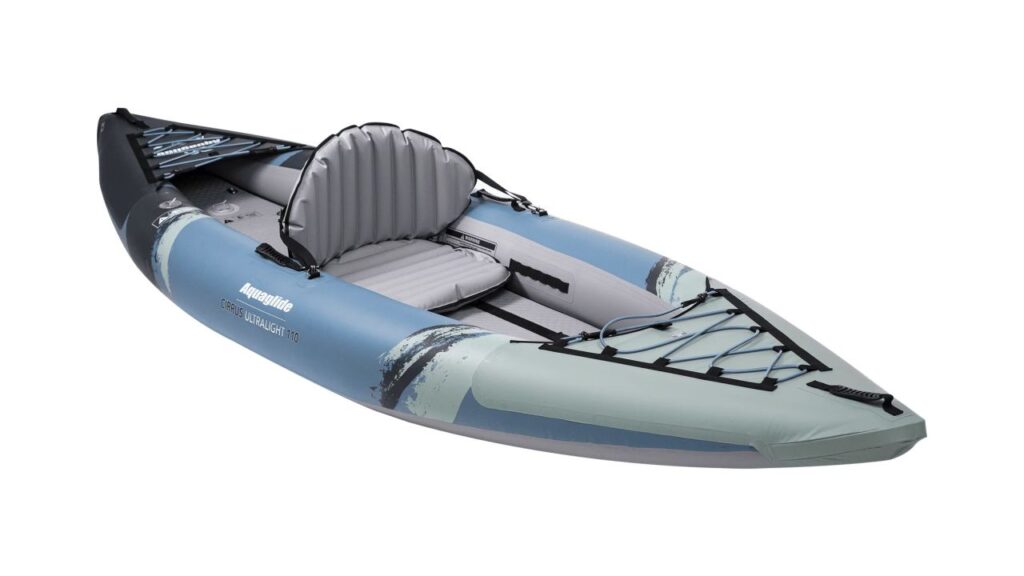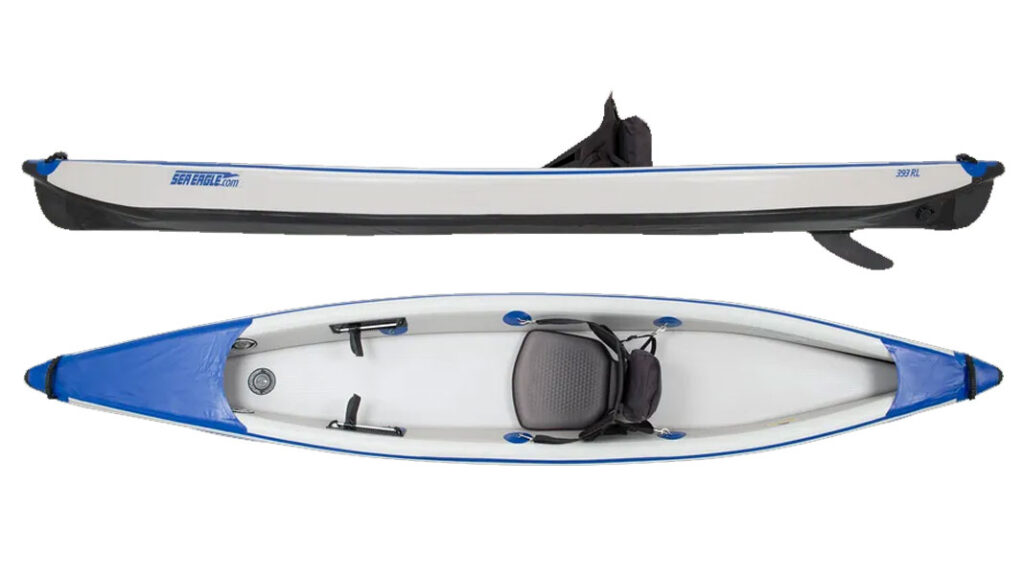Inflatable kayaks can be quite durable with proper care and maintenance. Made from rugged PVC or vinyl materials, they are resistant to punctures and UV damage. Their inflatable bladders provide rigidity, while the outer hull is abrasion-resistant.
Inflatable kayaks are lighter than hard shells, making them easier to transport and less prone to damage from impacts.
While less durable than hardshell kayaks, inflatables can last for years with basic precautions. Read on to learn more about how durable are inflatable kayaks & maximize the inflatable kayak durability.
How Durable Are Inflatable Kayaks?
Inflatable kayaks are surprisingly durable, crafted from tough materials like PVC, Hypalon, and Nitrylon, and resistant to punctures, abrasions, and UV damage. Modern designs incorporate multiple air chambers and drop-stitch technology, enhancing rigidity and inflatable kayak safety.
With proper care, these kayaks can last 7-10 years, offering a reliable option for recreational paddling, fishing, and exploring calm to moderate water conditions.

What Makes Inflatable Kayaks Durable?
How strong are inflatable kayaks? Best Inflatable kayaks are strong and can last a long time because they are made of special materials and built smartly. How durable are inflatable kayaks laid on their materials and components? They can go on many adventures without getting easily hurt. Let’s find out what makes them so tough.
Materials Used
Inflatable kayaks are made from strong stuff that can handle a lot of use. This is why they are so durable:
- PVC: A kind of plastic that’s really tough and can resist cuts and scratches.
- Hypalon: This is even stronger than PVC and can stand up to the sun without getting damaged.
- Nitrylon: It’s eco-friendly and very strong, making it perfect for kayaks.
Design Innovations
The way inflatable kayaks are built also makes them durable. Here’s how:
- Multiple Air Chambers: If one part gets a hole, the kayak won’t sink because there are separate sections filled with air.
- Drop-Stitch Technology: This makes the floor of the kayak very hard and flat, like a board, so it feels stable in the water.
Manufacturing Techniques
How inflatable kayaks are put together also plays a big role in their toughness:
- Seams: The edges where pieces of material are joined together are welded with heat, making them very strong.
- Reinforcement: Important parts of the kayak, like the bottom, have extra layers of material to protect against sharp objects.
Inflatable kayaks are designed to be strong and last long. They use tough materials, smart design, and careful building methods to make sure you can enjoy paddling without worrying about damage. Inflatable kayaks are good for the ocean and river. This is what makes them a great choice for water adventures.
Comparing Durability: Inflatable vs. Hardshell Kayaks
When deciding between an inflatable and a hardshell kayak, it’s important to know how each one holds up over time. Both have their strengths and uses, but today we’re focusing on how durable they are.

Inflatable Kayaks: What Makes Them Tough?
Inflatable kayaks are more rugged than you might think. Here’s why:
- Materials: They’re made from strong, puncture-resistant fabrics like PVC or Hypalon. This means they can bounce off rocks or logs without tearing.
- Design: Many have multiple air chambers. If one gets a hole, the others keep the kayak afloat. Plus, their surfaces are designed to withstand UV rays and salt water.
Hardshell Kayaks: Built to Last?
Hardshell kayaks are known for their toughness. Here’s their side of the story:
- Construction: They’re typically made from plastic, fiberglass, or composite materials. These materials can handle bumps and scrapes without much damage.
- Weight and Handling: Being heavier, they’re less likely to get pushed around by wind or currents. This can make them seem more stable and durable in rough waters.
Side by Side
- Puncture Resistance: Hardshells don’t puncture; inflatables can, but it’s rare with high-quality ones.
- Impact Resistance: Hardshells handle impacts better due to solid construction. Inflatables can absorb shocks well but might need more care in very rough conditions.
- Lifespan: Both can last a long time with proper care. Inflatables may need more maintenance, like patching small leaks.
- Use in Conditions: Hardshells are preferred for rocky, challenging waters. Inflatables are great for calm to moderate waters and are easier to transport and store.
Choosing between an inflatable and a hardshell kayak depends on where you plan to paddle, how you’ll transport your kayak, and how much maintenance you’re willing to do. Both types offer great adventures on the water with the right care.
Choosing a Durable Inflatable Kayak
Choosing a durable inflatable kayak means picking one that will last a long time and handle lots of adventures. It’s important to look at what the kayak is made of and how it’s put together.
What to Look For
- Material Quality: High-quality kayaks are usually made from PVC, Hypalon, or Nitrylon. These materials are tough and can resist punctures and sun damage.
- Construction: Good kayaks have multiple air chambers. This means if one part gets a hole, the kayak won’t sink. Look for kayaks with drop-stitch technology for extra firmness.
- Brand Reputation: Some brands are known for their durable kayaks. Do a little research or ask experienced kayakers for recommendations.
Tips
- Check reviews: See what other people say about the kayak’s durability.
- Think about usage: If you’re going on calm lakes, you might not need as tough a kayak as someone navigating rivers or coastal waters.
Choosing a durable inflatable kayak starts with knowing what makes them strong. Look for quality materials, and solid construction, and get recommendations from trusted sources.
Enhancing the Durability of Your Inflatable Kayak
To make your inflatable kayak last longer, it’s important to take good care of it. This means protecting it from damage and doing regular maintenance.
Tips for Keeping Your Kayak Durable
- Proper Inflation: Make sure you inflate your kayak just right. Too much air can stretch it out, and too little can make it saggy and more likely to get hurt.
- Avoid Sharp Objects: When you’re using or storing your kayak, keep it away from things that can poke holes in it, like sharp rocks or sticks.
- Clean and Dry: After each use, clean your kayak with fresh water and dry it completely before folding it up. This stops mold and mildew from growing.
Extra Care
- Storage: Store your kayak in a cool, dry place out of direct sunlight. Sunlight can weaken the material over time.
- Repair Kit: Keep a repair kit handy. Quick fixes can prevent small issues from becoming big problems.
Keeping it clean, dry, and properly inflated, along with storing it correctly, will enhance its durability significantly.
Pros And Cons Of Inflatable Kayaks
Inflatable kayaks are popular for people who love water adventures but don’t have much space. Like everything, they have good points and bad points.
Pros of Inflatable Kayaks
- Easy to Transport and Store: You can fold them up and put them in a bag, which makes them easy to carry and store anywhere, even in a small apartment or the trunk of a car.
- Lightweight: They’re usually lighter than hardshell kayaks, so carrying them to the water is easier.
- Stability: Inflatable kayaks are wide, which makes them stable and great for beginners or fishing.
Cons of Inflatable Kayaks
- Setting Up: You need to inflate them before each use, which takes time and effort. You also need to make sure they are dry before packing them away to avoid mold.
- Performance: While they’re stable, they might not move as smoothly or quickly in the water as hardshell kayaks, especially in windy conditions or strong currents.
Inflatable kayaks are great for those with limited storage space, who need a lightweight and stable option.

Closing Words
Inflatable kayaks offer surprising durability with proper care. Their tough materials, smart design, and easy maintenance make them ideal for various paddling adventures on calm to moderate waters. Hope you got your answer about how durable inflatable kayaks are.
By considering your needs and following these tips, you can choose and maintain a reliable inflatable kayak for years of enjoyment.
FAQs
With proper care and maintenance, an inflatable kayak can last between 7 to 10 years, depending on the frequency of use and storage conditions.
No, inflatable kayaks are made of durable materials like PVC and Hypalon, making them resistant to tears and punctures when used and handled correctly.
Inflatable kayaks are surprisingly resistant to punctures thanks to tough materials and construction.
They can be as durable as solid hull kayaks with proper care.
Inflatable kayaks are designed to be airtight but can develop leaks due to punctures, valve issues, or wear over time. Regular checks can prevent major leaks.
Yes, you can leave an inflatable kayak inflated for convenience, but prolonged inflation without use, especially in direct sunlight, may stress the material over time.
Inflatable kayaks offer greater portability and easier storage than plastic kayaks but may not match the durability and performance in rough conditions of their hardshell counterparts.





[…] calm lakes or rivers, a recreational kayak is perfect. For ocean kayaking, look for something more inflatable kayak durability and stability. Inflatable kayaks good for the ocean and […]
[…] ocean kayaking means choosing a vessel that’s as ready for adventure as you are. Its blend of inflatable kayak durability, control, and comfort ensures you can focus on enjoying the vastness of the sea, with peace of mind […]
[…] and maneuver, ideal for calm waters and short trips. Heavier kayaks offer more stability and inflatable kayak durability, better suited for rough waters and longer expeditions. Choose based on your activities and […]